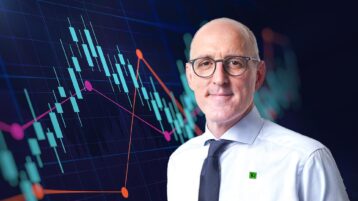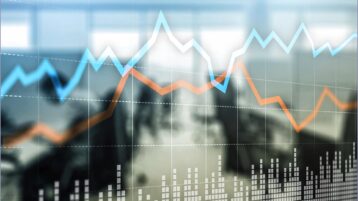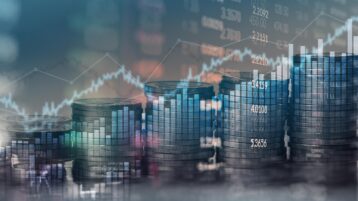The current market conditions have some investors turning to exchange traded funds as a way to diversify their portfolios and offset risk. Ian Tam, Director of Investment Research at Morningstar Research, speaks with Greg Bonnell about the different ETF trends emerging.
Print Transcript
[MUSIC PLAYING]
* One of the most active parts of the market is the exchange traded fund space with new types of ETFs constantly being launched. Joining us now to discuss some of the big trends in that sector is Ian Tam, director of Investment Research at Canada for Canada at Morningstar Research. Ian, great to have you on the show. It's your first time here. A pleasure.
* Greg, thanks for having me.
* All right, since this it's your first time on the show, and our viewers aren't familiar with you, talk a bit about before we get into the ETFs about your work at Morningstar. What are you doing?
* Sure, yeah, so that, I mean, maybe we'll start with the Morningstar as a company.
[CLEARS THROAT]
* The full name of the company is actually Morningstar Research. And as the name implies, we really focus on research that powers or empowers investors' success. Or in other words, how do you help investors make better decisions to reach their financial goals? And that's what we do.
So aside from providing research that's largely retail investor focus, we also provide data and analytics to all segments of the markets, including advisors, asset managers, pensions, as well as regulators here in Canada. We also actually have some pretty deep roots in Canada. Aside from Morningstar's own history, we had a recent acquisition of DBRS, one of the larger credit ratings agencies here in Canada, as well as Sustainalytics formerly known as Jantzi Research, which was also founded right here in Canada, a global leader in ESG research.
* Now, I know from using the platform myself, the platform that our show is on right now that you can find Morningstar research on here. Some people will see ratings attached to that. How does that work?
* Yeah, it's a great question. And there's three main ratings that Morningstar publishes in Canada. And I'll use the icons that we publish their stars, medalists, so gold, silver, bronze, neutral, negative, and then globes. And they measure three very different things. I think it's important to understand the differences as an investor.
The star ratings, which are probably the most prevalent, they are a very objective look back at risk-adjusted returns after fees relative to category peers. So it's there is no very little opinion placed on it. It largely depends on the peer group to which that investment fund belongs. That's the star rating.
The medalist rating is a bit more qualitative in nature. It's forward-looking. And that's Morningstar's assessment of a fund's ability to produce alpha after fees in the future. And so that is based on our assessment of three pillars of funds. That's the parent company, the process, and then the people that are running the fund. So parent process people. Those inputs go into us deriving this rating, and it's forward-looking.
And finally, the globe ratings are simply a roll up of ESG. Risk is not greenness or goodness or badness. It's the amount of material risk coming from ESG-related issues that are rolled up at the portfolio level. So those are three different ratings that's often good to know what you're looking at when you're looking at a rating from Morningstar,
* Great, helpful for our viewers who have been going through the platform and seeing some of these reports. Let's talk about ETFs now. So we're here to talk about a great introduction to who Ian is, what he does. What about some of the trends we're seeing lately?
* Yeah, so I think it's important to understand to actually paint the picture of how much ETFs have exploded in Canada. So in 2000, I just took some stats here. In 2003, there were 13 ETFs available for trade in Canada. In 2013, there were 250. And today, there's over 1,300. So there's exponential growth rate of the number of ETFs.
If you look at the last three years, though, a few kind of trends have emerged. Namely, the last 12 months, we've seen a number of covered call ETFs. As we come out of a low-interest rate environment, it's kind of interesting because these ETFs are really designed to produce an income or a yield while sacrificing a bit of the upside.
So it remains to be seen how they do as interest rates are now much higher. Perhaps, there is a different demand for yield in the market. So we've seen a lot of those. We've certainly seen a lot of thematic ETFs. So things that are ETFs that kind of cross different sectors. So things like Bitcoin, the idea of big data, autonomous technology.
So a number of these kind of themes have come up. And Morningstar certainly has an opinion on those. But there certainly been a number of launches in that area to date. The ones, the areas that we, I think, that investors should pay attention to are a bit more boring in nature. So the all-in-one ETF or the balanced ETF is a newer, I guess, front runner in things to look at as well as target date ETFs, which are, again, very boring type of instruments, but useful and helpful in getting to your retirement goals.
* People might have seen it. I've noticed these balanced ETFs out there and being a little more prevalent, at least, in terms of being in front of me. Let's talk about the pros and cons there. When we were talking about a balanced ETF, sort of what it is, and how does it differ from just buying your own suite of ETFs?
* Yeah, so the balanced ETF, the idea of a balanced fund is not new. They put this into the ETF world now. The all-in-one concept is unique in that the underlying funds that power the all-in-one product are typically low-cost index funds, which is a bit different than your traditional balanced product, which can be active and passive or a combination.
So the pros in buying one of these balanced ETFs is that it's easy, right? So instead of picking 20 different ETFs on your own and having to rebalance that once a quarter or how often you do it, that's a lot of work for most investors. And I would imagine that most retail investors probably aren't thinking about all the exposures that are granted within an all in one.
So particularly emerging market region, particular asset classes, like, private credit, for example. So these are areas that most retail investors aren't really actively thinking about. So by buying an all-in-one ETF, you're kind of giving that responsibility in a way to the ETF manufacturer. And I think for the most part, they do offer that. They offer diversification not only amongst asset classes but amongst regions as well.
So the pros is that it's easy. It's one ticker. You have it, and you don't have to do very much with it. The cons-- and much like everything that's kind of all in one is customization. There's an argument that in less efficient markets or markets where the information is not readily available to investors-- for example, developing or emerging markets like Russia, India, China, it can be argued that active management might produce more alpha in those markets.
So in an all-in-one ETF, you don't have that choice. It's the ETF manufacturer makes that call for you. It generally is passive because it's lower cost, and that's the intent. A more savvy investor may want to be active in certain markets. So that's one of the cons in one of these all-in-one products.
And the second is that these all-in-one products tend to take advantage of economies of scale. So typically the underlying funds that power the all in one are from the same fund manufacturer, right? So they get the lower price, and they get the economies of scale.
It's not very often that the same asset manager is the best across all different parts of the asset allocation. So perhaps, fund manager A is really good at emerging markets. fund manager B is really good at Canadian equity. You don't get to choose that. So with the idea of customization, that's I guess one of the cons.
* When you talk about all-in-one fund, some people may think, Oh, well, how is that any different than, I guess, a robo-advisor? And then we've seen robo-advisors sort of gain prominence in recent years.
* Yeah, so I think the main difference between the all in one and robo, they're similar in that that you're going to be holding a basket of low-cost ETFs at the end of the day. The feature that the robo-advisor gives you is very important. It's the risk tolerance or risk profiling function. So as a new investor, let's say, you have very-- most investors don't have an idea of how much risk they can take on.
And one way to gauge that is through this risk profiling or risk tolerance questionnaire traditionally. And that's what a robo-advisor can do for you. They can gauge, OK, based on your age, your financial status, here's how much risk you can take on. And we're going to match you with a portfolio that kind of matches that amount of risk. For an all-in-one ETF, you kind of do that on your own. And then maybe not all investors can have that skill set to do it. The robo gives you that additional, I guess, input at the start of your investment.
Then over time, what the robo-advisor does is essentially gives you a glide path. So as you close in on the time that you need to withdraw your money, perhaps, retirement or a child's education, they de-risk you. So they reduce your exposure to stocks and increase your exposure to bonds. And all-in-one ETF is a static asset allocation. So you're going to have a static-- roughly a static mix between stocks and bonds.
So that de-risking feature, especially if you're not a very diligent investor, which not everyone is, is useful, right? They can do that gradually over time. And by the time you need your money, you're going to have the least amount of risk in your portfolio, which is exactly what you want. And I think one of the pinnacles of a good investor is being able to get your money out when you need it.
[MUSIC PLAYING]
* One of the most active parts of the market is the exchange traded fund space with new types of ETFs constantly being launched. Joining us now to discuss some of the big trends in that sector is Ian Tam, director of Investment Research at Canada for Canada at Morningstar Research. Ian, great to have you on the show. It's your first time here. A pleasure.
* Greg, thanks for having me.
* All right, since this it's your first time on the show, and our viewers aren't familiar with you, talk a bit about before we get into the ETFs about your work at Morningstar. What are you doing?
* Sure, yeah, so that, I mean, maybe we'll start with the Morningstar as a company.
[CLEARS THROAT]
* The full name of the company is actually Morningstar Research. And as the name implies, we really focus on research that powers or empowers investors' success. Or in other words, how do you help investors make better decisions to reach their financial goals? And that's what we do.
So aside from providing research that's largely retail investor focus, we also provide data and analytics to all segments of the markets, including advisors, asset managers, pensions, as well as regulators here in Canada. We also actually have some pretty deep roots in Canada. Aside from Morningstar's own history, we had a recent acquisition of DBRS, one of the larger credit ratings agencies here in Canada, as well as Sustainalytics formerly known as Jantzi Research, which was also founded right here in Canada, a global leader in ESG research.
* Now, I know from using the platform myself, the platform that our show is on right now that you can find Morningstar research on here. Some people will see ratings attached to that. How does that work?
* Yeah, it's a great question. And there's three main ratings that Morningstar publishes in Canada. And I'll use the icons that we publish their stars, medalists, so gold, silver, bronze, neutral, negative, and then globes. And they measure three very different things. I think it's important to understand the differences as an investor.
The star ratings, which are probably the most prevalent, they are a very objective look back at risk-adjusted returns after fees relative to category peers. So it's there is no very little opinion placed on it. It largely depends on the peer group to which that investment fund belongs. That's the star rating.
The medalist rating is a bit more qualitative in nature. It's forward-looking. And that's Morningstar's assessment of a fund's ability to produce alpha after fees in the future. And so that is based on our assessment of three pillars of funds. That's the parent company, the process, and then the people that are running the fund. So parent process people. Those inputs go into us deriving this rating, and it's forward-looking.
And finally, the globe ratings are simply a roll up of ESG. Risk is not greenness or goodness or badness. It's the amount of material risk coming from ESG-related issues that are rolled up at the portfolio level. So those are three different ratings that's often good to know what you're looking at when you're looking at a rating from Morningstar,
* Great, helpful for our viewers who have been going through the platform and seeing some of these reports. Let's talk about ETFs now. So we're here to talk about a great introduction to who Ian is, what he does. What about some of the trends we're seeing lately?
* Yeah, so I think it's important to understand to actually paint the picture of how much ETFs have exploded in Canada. So in 2000, I just took some stats here. In 2003, there were 13 ETFs available for trade in Canada. In 2013, there were 250. And today, there's over 1,300. So there's exponential growth rate of the number of ETFs.
If you look at the last three years, though, a few kind of trends have emerged. Namely, the last 12 months, we've seen a number of covered call ETFs. As we come out of a low-interest rate environment, it's kind of interesting because these ETFs are really designed to produce an income or a yield while sacrificing a bit of the upside.
So it remains to be seen how they do as interest rates are now much higher. Perhaps, there is a different demand for yield in the market. So we've seen a lot of those. We've certainly seen a lot of thematic ETFs. So things that are ETFs that kind of cross different sectors. So things like Bitcoin, the idea of big data, autonomous technology.
So a number of these kind of themes have come up. And Morningstar certainly has an opinion on those. But there certainly been a number of launches in that area to date. The ones, the areas that we, I think, that investors should pay attention to are a bit more boring in nature. So the all-in-one ETF or the balanced ETF is a newer, I guess, front runner in things to look at as well as target date ETFs, which are, again, very boring type of instruments, but useful and helpful in getting to your retirement goals.
* People might have seen it. I've noticed these balanced ETFs out there and being a little more prevalent, at least, in terms of being in front of me. Let's talk about the pros and cons there. When we were talking about a balanced ETF, sort of what it is, and how does it differ from just buying your own suite of ETFs?
* Yeah, so the balanced ETF, the idea of a balanced fund is not new. They put this into the ETF world now. The all-in-one concept is unique in that the underlying funds that power the all-in-one product are typically low-cost index funds, which is a bit different than your traditional balanced product, which can be active and passive or a combination.
So the pros in buying one of these balanced ETFs is that it's easy, right? So instead of picking 20 different ETFs on your own and having to rebalance that once a quarter or how often you do it, that's a lot of work for most investors. And I would imagine that most retail investors probably aren't thinking about all the exposures that are granted within an all in one.
So particularly emerging market region, particular asset classes, like, private credit, for example. So these are areas that most retail investors aren't really actively thinking about. So by buying an all-in-one ETF, you're kind of giving that responsibility in a way to the ETF manufacturer. And I think for the most part, they do offer that. They offer diversification not only amongst asset classes but amongst regions as well.
So the pros is that it's easy. It's one ticker. You have it, and you don't have to do very much with it. The cons-- and much like everything that's kind of all in one is customization. There's an argument that in less efficient markets or markets where the information is not readily available to investors-- for example, developing or emerging markets like Russia, India, China, it can be argued that active management might produce more alpha in those markets.
So in an all-in-one ETF, you don't have that choice. It's the ETF manufacturer makes that call for you. It generally is passive because it's lower cost, and that's the intent. A more savvy investor may want to be active in certain markets. So that's one of the cons in one of these all-in-one products.
And the second is that these all-in-one products tend to take advantage of economies of scale. So typically the underlying funds that power the all in one are from the same fund manufacturer, right? So they get the lower price, and they get the economies of scale.
It's not very often that the same asset manager is the best across all different parts of the asset allocation. So perhaps, fund manager A is really good at emerging markets. fund manager B is really good at Canadian equity. You don't get to choose that. So with the idea of customization, that's I guess one of the cons.
* When you talk about all-in-one fund, some people may think, Oh, well, how is that any different than, I guess, a robo-advisor? And then we've seen robo-advisors sort of gain prominence in recent years.
* Yeah, so I think the main difference between the all in one and robo, they're similar in that that you're going to be holding a basket of low-cost ETFs at the end of the day. The feature that the robo-advisor gives you is very important. It's the risk tolerance or risk profiling function. So as a new investor, let's say, you have very-- most investors don't have an idea of how much risk they can take on.
And one way to gauge that is through this risk profiling or risk tolerance questionnaire traditionally. And that's what a robo-advisor can do for you. They can gauge, OK, based on your age, your financial status, here's how much risk you can take on. And we're going to match you with a portfolio that kind of matches that amount of risk. For an all-in-one ETF, you kind of do that on your own. And then maybe not all investors can have that skill set to do it. The robo gives you that additional, I guess, input at the start of your investment.
Then over time, what the robo-advisor does is essentially gives you a glide path. So as you close in on the time that you need to withdraw your money, perhaps, retirement or a child's education, they de-risk you. So they reduce your exposure to stocks and increase your exposure to bonds. And all-in-one ETF is a static asset allocation. So you're going to have a static-- roughly a static mix between stocks and bonds.
So that de-risking feature, especially if you're not a very diligent investor, which not everyone is, is useful, right? They can do that gradually over time. And by the time you need your money, you're going to have the least amount of risk in your portfolio, which is exactly what you want. And I think one of the pinnacles of a good investor is being able to get your money out when you need it.
[MUSIC PLAYING]



























